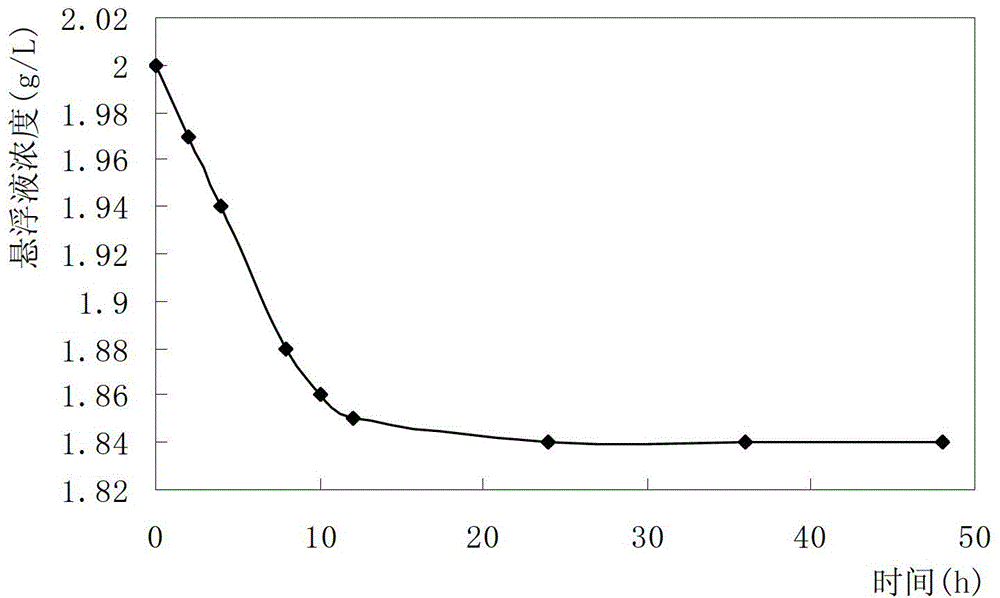A composite nano-adsorbent for removing trivalent chromium ions in wastewater and its removal method
A composite adsorption and nano-adsorption technology, applied in chemical instruments and methods, adsorption of water/sewage treatment, water pollutants, etc., can solve the problems of high cost and unstable effect, and achieve low cost, not easy to secondary pollution, easy The effect obtained
- Summary
- Abstract
- Description
- Claims
- Application Information
AI Technical Summary
Problems solved by technology
Method used
Image
Examples
Embodiment 1
[0019] Treatment of industrial wastewater with a trivalent chromium ion concentration of 20mg / L:
[0020] Sodium hydroxide and sulfuric acid were added to adjust the pH of the industrial wastewater with a trivalent chromium ion concentration of 20 mg / L to be 5. Under the condition of pneumatic ultrasonic (frequency is 20kHz, ultrasonic power is 800W), to the industrial waste water, according to the concentration of nano-ferric oxide 1g / L, the concentration of nano-nickel 1g / L, add the concentration of nano-ferric oxide and nano-nickel. The composite adsorbent is subjected to pneumatic ultrasonication at 20-25°C for 60 minutes, and is adsorbed by a magnet to separate the composite nano-adsorbent from wastewater.
[0021] It is measured that in the treated industrial wastewater, the concentration of trivalent chromium ions is 0mg / L, and the adsorption capacity △=20mg / L.
Embodiment 2
[0039] Treatment of industrial wastewater with a trivalent chromium ion concentration of 50mg / L:
[0040] Add sodium hydroxide and hydrochloric acid to adjust the pH to 6 in industrial wastewater with a trivalent chromium ion concentration of 50 mg / L. Under pneumatic ultrasonic conditions (frequency is 40kHz, ultrasonic power is 800W), according to the concentration of nano-ferric oxide 2g / L, the concentration of nano-cobalt 2g / L, add composite adsorption of nano-ferric oxide and nano-cobalt to the above wastewater Add glycerol as a dispersant (according to the concentration of 2g / L), perform pneumatic ultrasonication at 20-25°C for 60 minutes, and adsorb with a magnet to separate the composite nano-adsorbent from wastewater.
[0041] It is measured that in the treated industrial wastewater, the concentration of trivalent chromium ions is 1.7mg / L, and the adsorption capacity △=48.3mg / L.
Embodiment 3
[0058] Treatment of industrial wastewater with a trivalent chromium ion concentration of 5 mg / L:
[0059] Add sodium hydroxide and sulfuric acid to adjust the pH to 4 in industrial wastewater with a trivalent chromium ion concentration of 5 mg / L. Under pneumatic ultrasonic conditions (frequency is 20kHz, ultrasonic power is 300W), according to the concentration of nano-ferric oxide 0.5g / L, the concentration of nano-nickel is 0.5g / L, add nano-ferric oxide and nano-nickel to the above wastewater The composite adsorbent is subjected to pneumatic ultrasonication at 20-25°C for 5 minutes, and is adsorbed by a magnet to separate the composite nano-adsorbent from wastewater.
[0060] It is measured that in the treated industrial wastewater, the concentration of trivalent chromium ions is 0 mg / L, and the adsorption capacity △=5 mg / L.
PUM
| Property | Measurement | Unit |
|---|---|---|
| diameter | aaaaa | aaaaa |
| adsorption capacity | aaaaa | aaaaa |
| adsorption capacity | aaaaa | aaaaa |
Abstract
Description
Claims
Application Information
 Login to View More
Login to View More - R&D Engineer
- R&D Manager
- IP Professional
- Industry Leading Data Capabilities
- Powerful AI technology
- Patent DNA Extraction
Browse by: Latest US Patents, China's latest patents, Technical Efficacy Thesaurus, Application Domain, Technology Topic, Popular Technical Reports.
© 2024 PatSnap. All rights reserved.Legal|Privacy policy|Modern Slavery Act Transparency Statement|Sitemap|About US| Contact US: help@patsnap.com








